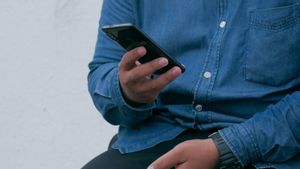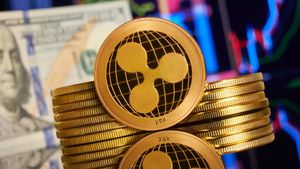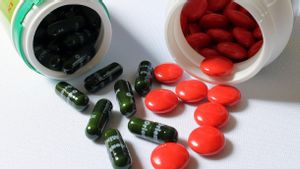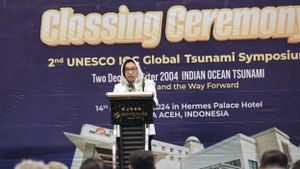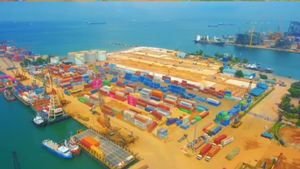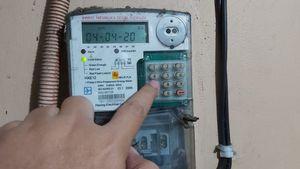JAKARTA - Celebrity, Deddy Corbuzier experienced a cytokine storm after being tested negative for COVID-19. Deddy said the medical situation made him almost die. Deddy also said the condition of his lungs had been damaged up to 60 percent. What happens to people with such severe lung damage? And what kind of cytokine storm did Deddy experience?
Deddy's body temperature had touched 41 degrees Celsius. Vertigo recurred. Two weeks before experiencing a cytokine storm, Deddy had tested positive for COVID-19. Three days into self-isolation, Deddy tested negative. "In the second week after I caught it and was not long negative, my fever suddenly rose to almost 40 degrees", Deddy said on his YouTube channel.
Deddy was then rushed to the Central Army Hospital. The Central Army Hospital had asked him to stay and undergo treatment at the hospital (RS). However, because the results of the examination of Deddy's oxygen levels showed 99 percent, the doctor allowed him to undergo outpatient treatment. During outpatient treatment, Deddy's condition dropped again.
"Then a CT thorax went to the Central Army Hospital. Then I was asked to stay in the hospital. But my oxygen level was still 99 percent, the doctor said if I wanted to stay at home it's okay ... When I first got hit I took some medicine. So I have followed the rules being carried out", added Deddy.
Deddy returned to the hospital. This time Medistra Hospital. There the doctor said Deddy had a cytokine storm. The condition had made him critical. "When the CT thorax checks 60 when at the Central Army Hospital it is still 30, it rises to 60 and the situation is in a cytokine storm condition". Deddy, who is confident because he feels he has taken care of his health, stated that he never expected all these conditions.
What happens to people whose lungs are damaged by up to 60 percent?
In principle, when a person has lung damage, the function of the lungs in taking oxygen will decrease. The more severe the damage, the harder the lungs work. People with lung damage will experience shorter breaths and ease shortness of breath.
In addition, several effects will be seen and felt, including dry cough and easy fatigue, including during exercise and daily activities. Others are finger clubbing to weight loss as a side effect of long-term lack of oxygen.
"When you exercise, you will feel shorter and easier to breathe, so you will experience changes in doing your daily activities", said general practitioner Nadia Hambali to VOI, Monday, August 23.
And lung damage as experienced by Deddy is non-reversible, which means that it cannot be repaired back to normal conditions. People with lung damage generally have to take medication and rehabilitation therapy to improve their quality of life.

Nadia said lung damage like Deddy's was a serious health problem. His condition can get worse "if the patient after recovering does not take care of his health anymore. For example, he is infected with the lungs again. Smoking", explained Nadia.
Or more concentrated air pollution. Such environmental conditions can worsen the condition of patients with lung damage. "But it can be overcome by using a mask, unless the exposure is continuous and heavy, yes".
The worst risk of lung damage is respiratory failure or ARDS. "If the damage is extensive, it can cause respiratory failure or acute respiratory distress syndrome (ARDS).
What is a cytokine storm and why is it deadly?
Cytokines are high levels of immune system proteins. The researchers found cytokines in the blood of COVID-19 patients with the most severe symptoms. Deaths from COVID-19 may be due to a chaotic immune response rather than the infection itself.
When the body's immune response escalates out of control, it will start attacking the body's own cells and tissues instead of fighting the virus, which is the real enemy. Cytokine storms are not a new health concern. It is known to occur in autoimmune diseases, such as juvenile arthritis. Cytokine storms also occur in some cancer treatments.
"Cytokines are divided into two, namely pro-inflammatory (increase) and anti-inflammatory (decrease) inflammation to maintain the balance of the immune response. Cytokine storm occurs when the release of pro-inflammatory cytokines is excessive, said general practitioner Nadia Hambali to VOI, Monday, August 23.
"So that the immune response that should only attack the virus, instead attacks healthy cells and body tissues. If left unchecked, there will be extensive and severe organ damage leading to multi-organ failure that causes death".
A few months ago, we remember the celebrity, Raditya Oloan Panggabean who breathed his last on Thursday, May 6. He had struggled against COVID-19, even from the ICU room at the Friendship Hospital.
On April 14, Raditya was confirmed positive for COVID-19. Joanna had uploaded her photo with Raditya while undergoing treatment at the Wisma Atlet Emergency Hospital. Three days later, Raditya was referred to the Friendship Hospital.
Raditya himself is known to have post-COVID with comorbid asthma. Raditya's news got worse and was attacked by a cytokine storm until finally, he died.
Cytokine storm link and COVID-19

In a study of patients who died of the H1N1 influenza virus, 81 percent of the characteristics of a cytokine storm were found. Dozens of other studies were conducted to find ways to save patients from a cytokine storm. Mukesh Kumar, a virologist, and an immunologist at Georgia State University, Atlanta, United States studies how the body responds to infection.
Mukesh, in a high-security lab, has been experimenting. He infected cells and animals with SARS-CoV-2 to study what happened. One thing he observed was that the virus multiplied very quickly after infecting a cell.
“There is a lot of stress on the cells in a short period of time… When each cell senses that something is foreign, that something bad is happening, the immediate response of the cell is to kill itself. This is a protective mechanism so it doesn't spread to other cells", Mukesh Kumar, quoted by WebMD, Friday, May 7.
Certain types of cytokines trigger cell death. Many tissues can die when a person experiences too much cell death. In COVID-19, that tissue is mostly in the lungs. When tissue is damaged, the walls of the tiny air sacs in the lungs leak and fill with fluid.
This condition causes pneumonia and triggers a lack of oxygen in the blood. Lung damage at a severe level will cause respiratory distress syndrome. From there, the other organs will begin to fail to function.
“Basically, most of your cells will die from a cytokine storm. It eats away at the lungs. They can't recover... It seems to play a role in the deaths in most cases”, Mukesh Kumar.
In his research, Kumar also discovered how the SARS-CoV-2 virus triggers up to fifty times more cytokine production. This level of production is much higher than how the body reacts to a Zika or West Nile virus infection.
*Read other information about COVID-19 or read other interesting articles from Yudhistira Mahabharata.
Other BERNAS
SEE ALSO:
The English, Chinese, Japanese, Arabic, and French versions are automatically generated by the AI. So there may still be inaccuracies in translating, please always see Indonesian as our main language. (system supported by DigitalSiber.id)






